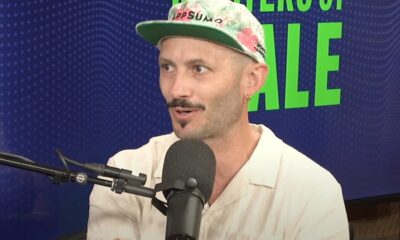MARKETING
Which Is Better for Your Business in 2022?

Short-form video is dominating the social media landscape — and many marketers want to get a piece of the action. But this leaves one important question: which video-sharing platform is worth your time, effort, and money — YouTube or TikTok?
While YouTube is the more mature platform, it’s hard to ignore the buzz around TikTok. In order to make the right decision, it’s essential to understand their unique audiences, marketing opportunities, and algorithms.
Let’s take a closer look at the key differences between YouTube and TikTok — and how to choose the right platform for your business.
YouTube vs. TikTok: A Head-to-Head Comparison
1. Demographics.
YouTube
With a global user base of more than 2 billion people, it’s safe to assume that your target audience is on YouTube. Let’s take a closer look at its user base.
YouTube holds sway with both men and women, almost in equal measure. Male users account for 53% of its population, while female users account for 46%.
The platform is also popular across different age groups. Outside of China, 77% of Gen Z, 75% of millennials, and 44% of Baby Boomers visit YouTube daily. Specifically, the 18-25 year age group commands the largest visitor base.
YouTube attracts a global audience, with more than 95% of the internet population using it. That said, India accounts for the largest audience size, followed by the United States and Indonesia.
TikTok
TikTok is known as the platform for Gen-Z — and the stats confirm it. Over half of Gen-Z consumers are on TikTok, and 46% of 13-19-year-olds say they use the platform daily.
However, TikTok is also picking up steam with other age groups. In 2021, 36% of TikTok users were between 35 and 54 years old, a 10% increase from the year before.
Unlike Youtube, TikTok’s user base skews primarily female (57% worldwide). That figure jumps to 61% for TikTok users in the US. While TikTok’s user base is increasingly diverse, there’s no denying its popularity among younger female audiences.
TikTok is a global platform available in 154 countries worldwide and in 75 different languages. The United States accounts for the largest user base (120 million users), followed by Indonesia, Brazil, and Russia.
2. Popularity.
There’s no real competition here (yet). YouTube commands an audience of over two billion monthly users — almost half of the entire internet-using population. It’s no surprise that one in five social media marketers plans to invest the most in YouTube this year, according to a recent HubSpot Blog’s report.
 However, TikTok is a relatively new platform with stellar growth year-over-year. TikTok was the most downloaded app in 2019 and 2020, racking up over three billion downloads so far. It also boasts 1.2 billion monthly users, which experts predict will reach 1.5 billion by the end of 2022 — keeping YouTube on its toes.
However, TikTok is a relatively new platform with stellar growth year-over-year. TikTok was the most downloaded app in 2019 and 2020, racking up over three billion downloads so far. It also boasts 1.2 billion monthly users, which experts predict will reach 1.5 billion by the end of 2022 — keeping YouTube on its toes.
Additionally, while TikTok doesn’t bring in the same monthly users, it certainly wins at engagement. In fact, TikTok is the most engaging of all social media apps, with an average user session of 10.85 minutes. As a result, 52% of marketers who use TikTok plan to increase their investment in 2022.
 3. Content Format and Length
3. Content Format and Length
YouTube
Unlike other social media platforms, YouTube has become the unofficial home for long-form content. For instance, you’ve likely stumbled upon a 30-minute workout video or even a 2-hour podcast on YouTube.
However, it’s impossible to deny the popularity of short-form video content. In fact, 31% of marketers are currently leveraging short-form video, and 29% plan to leverage it for the first time this year.
 In response, YouTube launched Shorts — enabling users to create 15-second videos with musical overlays. This also allows video marketers to play with different content types on the same platform.
In response, YouTube launched Shorts — enabling users to create 15-second videos with musical overlays. This also allows video marketers to play with different content types on the same platform.
TikTok
To put it plainly, TikTok is a short-form powerhouse. In fact, the app has become synonymous with fun, “snackable” content that attracts Gen-Z and millennial audiences.
Why does this matter? Short-form video is the most popular and effective social media format in 2022. So much so that 50% of social media marketers plan to leverage short-form video for the first time this year, and 95% of those who already use it will increase or maintain their investment.
Initially, TikTok videos could only be 15-seconds long. However, the app has extended the limit to 60 seconds. For marketers, this means more wiggle room to play around with video concepts. However, this only applies to videos recorded natively on the app.
4. Ad Formats
YouTube
YouTube ads are powered by Google. You have several ad formats to choose from, including:
- Discover ads — ads that appear on the YouTube homepage or search results pages.
- TrueView ads — also known as skippable ads, these are ads that play before a video.
- Non-skippable ads — ads that appear before, in the middle, or after a video.
- Bumper ads — 6-second ads that play before a video.
- Overlay ads — banner ads that appear at the bottom of a video.
YouTube offers a lot of flexibility for marketers to experiment with different ad formats. For example, you can opt for a quick, 6-second ad at the beginning of a video or a 30-second non-skippable ad in the middle of a video.
TikTok
Despite its “newness,” TikTok has become a viable option for brands willing to get creative with their digital marketing. So much so, it launched TikTok for Business in 2021, allowing marketers to create and manage ad campaigns on the platform.
Additionally, there are different ways to advertise on the platform, including:
- TopView — ads that appear at the top of their feed immediately after opening the app.
- In-Feed Ads — ads that appear on a user’s discovery page.
- Branded Hashtags — a hashtag that businesses promote in hopes of inspiring TikTokers to create content around it.
- Brand Takeovers — an ad format that can include TopView, In-Feed, and Branded Hashtags all at once. They can also be videos, gifs, or still images.
As we’ll discuss later, each ad format on TikTok has a different price tag — so even if you have a smaller budget, you can play your cards right with a solid strategy.
5. Ad Costs
YouTube
YouTube follows a cost-per-view pricing model. Each view can cost between $0.10 and $0.30, depending on your industry and target keywords. You only pay when a user takes action — such as watching the entirety of your ad or clicking on a call-to-action.
You can spend as little or as much as you want. However, most businesses invest $10 or more a day to run an advertising campaign on YouTube. If you set a daily budget, Google will only charge you up until that amount, making YouTube ads a relatively safe investment.
TikTok
If you decide to advertise on TikTok, you can select a daily or lifetime budget that can be adjusted at any point during your campaign. However, at the campaign level, you must have a minimum daily and total budget of $50. For an ad group level, your budget must exceed $20 daily.
It’s also important to note that TikTok doesn’t use cost-per-click as a metric. Instead, it uses cost-per-mille (CPM), which means cost per 1000 views. TikTok ads start at $10 per CPM, so it’s possible to make an impact at a relatively low cost.
Which platform is right for your business?
One final question remains — which platform is better for my business? Ultimately, the answer hinges on several factors.
First, who is your target audience? As you can see, both YouTube and TikTok boast diverse audiences, but TikTok commands a younger, predominantly female audience. YouTube, on the other hand, is popular across multiple age groups. To state the obvious, you should prioritize the platform that will reach your audience.
Second, what type of content do you want to make? Does it lend itself more to lighthearted, snappy videos or longer, more in-depth ones? Is 15 seconds long enough to convey your message, or do you need more time?
Lastly, it’s important to consider your budget. YouTube offers more flexibility in choosing a daily budget. And, since it follows a cost-per-view pricing model, you only pay when a user takes action. To run a campaign on TikTok, you must commit to a daily budget of $50, which quickly adds up.
With these questions in mind, you have a better idea of which platform is right for your business. But remember, marketing is all about experimentation. You don’t need to commit to one platform right away — in fact, it may be useful to run side experiments on both to see what results you get.
MARKETING
YouTube Ad Specs, Sizes, and Examples [2024 Update]
![YouTube Ad Specs, Sizes, and Examples [2024 Update] YouTube Ad Specs, Sizes, and Examples](https://articles.entireweb.com/wp-content/uploads/2024/06/YouTube-Ad-Specs-Sizes-and-Examples.jpg)
Introduction
With billions of users each month, YouTube is the world’s second largest search engine and top website for video content. This makes it a great place for advertising. To succeed, advertisers need to follow the correct YouTube ad specifications. These rules help your ad reach more viewers, increasing the chance of gaining new customers and boosting brand awareness.
Types of YouTube Ads
Video Ads
- Description: These play before, during, or after a YouTube video on computers or mobile devices.
- Types:
- In-stream ads: Can be skippable or non-skippable.
- Bumper ads: Non-skippable, short ads that play before, during, or after a video.
Display Ads
- Description: These appear in different spots on YouTube and usually use text or static images.
- Note: YouTube does not support display image ads directly on its app, but these can be targeted to YouTube.com through Google Display Network (GDN).
Companion Banners
- Description: Appears to the right of the YouTube player on desktop.
- Requirement: Must be purchased alongside In-stream ads, Bumper ads, or In-feed ads.
In-feed Ads
- Description: Resemble videos with images, headlines, and text. They link to a public or unlisted YouTube video.
Outstream Ads
- Description: Mobile-only video ads that play outside of YouTube, on websites and apps within the Google video partner network.
Masthead Ads
- Description: Premium, high-visibility banner ads displayed at the top of the YouTube homepage for both desktop and mobile users.
YouTube Ad Specs by Type
Skippable In-stream Video Ads
- Placement: Before, during, or after a YouTube video.
- Resolution:
- Horizontal: 1920 x 1080px
- Vertical: 1080 x 1920px
- Square: 1080 x 1080px
- Aspect Ratio:
- Horizontal: 16:9
- Vertical: 9:16
- Square: 1:1
- Length:
- Awareness: 15-20 seconds
- Consideration: 2-3 minutes
- Action: 15-20 seconds
Non-skippable In-stream Video Ads
- Description: Must be watched completely before the main video.
- Length: 15 seconds (or 20 seconds in certain markets).
- Resolution:
- Horizontal: 1920 x 1080px
- Vertical: 1080 x 1920px
- Square: 1080 x 1080px
- Aspect Ratio:
- Horizontal: 16:9
- Vertical: 9:16
- Square: 1:1
Bumper Ads
- Length: Maximum 6 seconds.
- File Format: MP4, Quicktime, AVI, ASF, Windows Media, or MPEG.
- Resolution:
- Horizontal: 640 x 360px
- Vertical: 480 x 360px
In-feed Ads
- Description: Show alongside YouTube content, like search results or the Home feed.
- Resolution:
- Horizontal: 1920 x 1080px
- Vertical: 1080 x 1920px
- Square: 1080 x 1080px
- Aspect Ratio:
- Horizontal: 16:9
- Square: 1:1
- Length:
- Awareness: 15-20 seconds
- Consideration: 2-3 minutes
- Headline/Description:
- Headline: Up to 2 lines, 40 characters per line
- Description: Up to 2 lines, 35 characters per line
Display Ads
- Description: Static images or animated media that appear on YouTube next to video suggestions, in search results, or on the homepage.
- Image Size: 300×60 pixels.
- File Type: GIF, JPG, PNG.
- File Size: Max 150KB.
- Max Animation Length: 30 seconds.
Outstream Ads
- Description: Mobile-only video ads that appear on websites and apps within the Google video partner network, not on YouTube itself.
- Logo Specs:
- Square: 1:1 (200 x 200px).
- File Type: JPG, GIF, PNG.
- Max Size: 200KB.
Masthead Ads
- Description: High-visibility ads at the top of the YouTube homepage.
- Resolution: 1920 x 1080 or higher.
- File Type: JPG or PNG (without transparency).
Conclusion
YouTube offers a variety of ad formats to reach audiences effectively in 2024. Whether you want to build brand awareness, drive conversions, or target specific demographics, YouTube provides a dynamic platform for your advertising needs. Always follow Google’s advertising policies and the technical ad specs to ensure your ads perform their best. Ready to start using YouTube ads? Contact us today to get started!
MARKETING
Why We Are Always ‘Clicking to Buy’, According to Psychologists

Amazon pillows.
MARKETING
A deeper dive into data, personalization and Copilots

Salesforce launched a collection of new, generative AI-related products at Connections in Chicago this week. They included new Einstein Copilots for marketers and merchants and Einstein Personalization.
To better understand, not only the potential impact of the new products, but the evolving Salesforce architecture, we sat down with Bobby Jania, CMO, Marketing Cloud.
Dig deeper: Salesforce piles on the Einstein Copilots
Salesforce’s evolving architecture
It’s hard to deny that Salesforce likes coming up with new names for platforms and products (what happened to Customer 360?) and this can sometimes make the observer wonder if something is brand new, or old but with a brand new name. In particular, what exactly is Einstein 1 and how is it related to Salesforce Data Cloud?
“Data Cloud is built on the Einstein 1 platform,” Jania explained. “The Einstein 1 platform is our entire Salesforce platform and that includes products like Sales Cloud, Service Cloud — that it includes the original idea of Salesforce not just being in the cloud, but being multi-tenancy.”
Data Cloud — not an acquisition, of course — was built natively on that platform. It was the first product built on Hyperforce, Salesforce’s new cloud infrastructure architecture. “Since Data Cloud was on what we now call the Einstein 1 platform from Day One, it has always natively connected to, and been able to read anything in Sales Cloud, Service Cloud [and so on]. On top of that, we can now bring in, not only structured but unstructured data.”
That’s a significant progression from the position, several years ago, when Salesforce had stitched together a platform around various acquisitions (ExactTarget, for example) that didn’t necessarily talk to each other.
“At times, what we would do is have a kind of behind-the-scenes flow where data from one product could be moved into another product,” said Jania, “but in many of those cases the data would then be in both, whereas now the data is in Data Cloud. Tableau will run natively off Data Cloud; Commerce Cloud, Service Cloud, Marketing Cloud — they’re all going to the same operational customer profile.” They’re not copying the data from Data Cloud, Jania confirmed.
Another thing to know is tit’s possible for Salesforce customers to import their own datasets into Data Cloud. “We wanted to create a federated data model,” said Jania. “If you’re using Snowflake, for example, we more or less virtually sit on your data lake. The value we add is that we will look at all your data and help you form these operational customer profiles.”
Let’s learn more about Einstein Copilot
“Copilot means that I have an assistant with me in the tool where I need to be working that contextually knows what I am trying to do and helps me at every step of the process,” Jania said.
For marketers, this might begin with a campaign brief developed with Copilot’s assistance, the identification of an audience based on the brief, and then the development of email or other content. “What’s really cool is the idea of Einstein Studio where our customers will create actions [for Copilot] that we hadn’t even thought about.”
Here’s a key insight (back to nomenclature). We reported on Copilot for markets, Copilot for merchants, Copilot for shoppers. It turns out, however, that there is just one Copilot, Einstein Copilot, and these are use cases. “There’s just one Copilot, we just add these for a little clarity; we’re going to talk about marketing use cases, about shoppers’ use cases. These are actions for the marketing use cases we built out of the box; you can build your own.”
It’s surely going to take a little time for marketers to learn to work easily with Copilot. “There’s always time for adoption,” Jania agreed. “What is directly connected with this is, this is my ninth Connections and this one has the most hands-on training that I’ve seen since 2014 — and a lot of that is getting people using Data Cloud, using these tools rather than just being given a demo.”
What’s new about Einstein Personalization
Salesforce Einstein has been around since 2016 and many of the use cases seem to have involved personalization in various forms. What’s new?
“Einstein Personalization is a real-time decision engine and it’s going to choose next-best-action, next-best-offer. What is new is that it’s a service now that runs natively on top of Data Cloud.” A lot of real-time decision engines need their own set of data that might actually be a subset of data. “Einstein Personalization is going to look holistically at a customer and recommend a next-best-action that could be natively surfaced in Service Cloud, Sales Cloud or Marketing Cloud.”
Finally, trust
One feature of the presentations at Connections was the reassurance that, although public LLMs like ChatGPT could be selected for application to customer data, none of that data would be retained by the LLMs. Is this just a matter of written agreements? No, not just that, said Jania.
“In the Einstein Trust Layer, all of the data, when it connects to an LLM, runs through our gateway. If there was a prompt that had personally identifiable information — a credit card number, an email address — at a mimum, all that is stripped out. The LLMs do not store the output; we store the output for auditing back in Salesforce. Any output that comes back through our gateway is logged in our system; it runs through a toxicity model; and only at the end do we put PII data back into the answer. There are real pieces beyond a handshake that this data is safe.”
-

 SEARCHENGINES5 days ago
SEARCHENGINES5 days agoBillions Of Google goo.gl URLs To 404 In The Future
-

 SEO7 days ago
SEO7 days ago26 Common SEO Myths, Debunked
-
SEARCHENGINES4 days ago
Daily Search Forum Recap: July 22, 2024
-

 SEO5 days ago
SEO5 days ago11 Copyscape Alternatives To Check Plagiarism
-

 SEARCHENGINES6 days ago
SEARCHENGINES6 days agoGoogle Core Update Coming, Ranking Volatility, Bye Search Notes, AI Overviews, Ads & More
-

 SEO6 days ago
SEO6 days agoGoogle Warns Of Last Chance To Export Notes Search Data
-
SEARCHENGINES3 days ago
Daily Search Forum Recap: July 23, 2024
-

 AFFILIATE MARKETING6 days ago
AFFILIATE MARKETING6 days agoThe Top 5 AI Tools That Can Revolutionize Your Workflow and Boost Productivity

















You must be logged in to post a comment Login